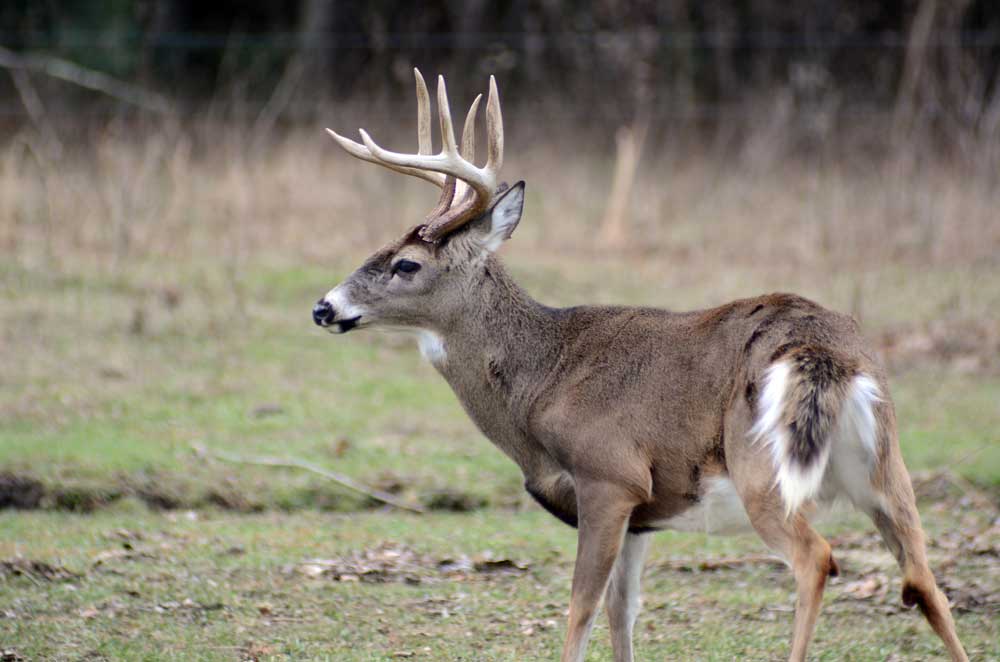Ron Jolly | Originally published in GameKeepers: Farming for Wildlife Magazine

The basic elements for successful deer scouting are: know where the deer are bedding, know what they are eating, play the wind and shoot them somewhere along that line of travel. Many hunters depend on food plots to attract the deer they want to harvest, yet some fail to realize just how important acorns are to whitetails. When acorns are abundant, there will be a noticeable reduction of deer activity in food plots, agricultural cash-crops and just about all other food sources. Managers should learn to use this important resource to their advantage.
Whitetails are opportunists. Nutritious, easily accessed food is always preferred. Acorns, when abundant, are both. They are easy for deer to find and preferred as a food source. In fact, acorns are the preferred food source of white-tailed deer.
The last several years have been a roller coaster ride of acorn production in Alabama. In 2007 the acorn crop on our farm was of biblical proportions despite the ravages of a fifteen month drought. The following year hardwoods produced another bumper acorn crop in east central Alabama. The acorn crop of 2009 was what I would call normal and in 2010 acorns were almost non-existent. The next three years yielded the normal rotation of one species producing acorns while another did not. 2014 promises a good crop of water oaks and red oaks. Having a variety of oaks will obviously be the most consistent and wisest management decision.
ACORN FACTS
Typically in any given year there will be one species of oaks that produces well. It seems as if one year red oak tree acorns will do well and white oak tree acorns will not and another year white oaks flourish and the red oaks are weak in production. Water oaks in the Black Belt region of Alabama produce to some extent annually but rarely do all species produce bumper crops during the same year.
On our farm in Macon County, Alabama, the acorn crop was enormous! In early September, sawtooth oaks began dropping. The deer immediately began hitting them. In October, water oaks started raining acorns. In January I actually saw grey squirrels feeding on hanging water oak acorns. In January! Acorns still on trees! Unheard of!

on those acorns you should also see numerous droppings and tracks.
In November the swamp chestnut oaks, white oaks, and red oaks began dropping, continuing well into December. By Christmas the ground was literally covered with acorns and life was good for the deer in Alabama.
FAT DEER
Acorns are low in protein content, (6%) but high in carbohydrates, (42%) and fats (52%). They are easily digested and the nutrients are readily absorbed as they are processed and passed through a deer’s body. Because deer digest acorns so easily they eat lots of them each day and the sheer numbers eaten by individual deer provide the protein needed for a healthy herd.
One lease we hunt in Alabama keeps records of deer weights harvested on the property. For the 2007-08 season, the average mature doe weight was up five pounds and the average mature buck weight was up 8 pounds.
We also weigh all deer harvested on our farm. Years with good acorn production always produce fat deer. The deer I harvested in the 2007-08 season were fat! I shot two bucks with heavy layers of fat on their rumps, brisket and ribs. The two does I shot were unusually fat for does in our area. The stomach contents of all four deer contained acorns. Deer harvested on both properties during the 2010-11 season, were down on body weight and lacked layers of fat. Stomach contents revealed heavy food plot consumption but no acorns.
ALL ACORNS ARE NOT CREATED EQUAL
Just because you find acorns on the ground does not necessarily mean you have hit the deer scouting lotto and found a deer hotspot. Whitetails prefer certain varieties of acorns over others. However, when times are tough they will eat all varieties.
All acorns contain tannic acid and deer prefer acorns with the least amount. White oak acorns, the number one hard mast choice for deer, contain the least amount of tannic acid. Preference can vary by region. In my area, they seem to favor the pin oak or water oak, followed by red oaks, black oaks, burr oaks and live oaks.
As the season progresses, deer consume the white oaks and move onto the lesser desired varieties. In areas where there are no white oaks, deer will feed on the acorns available with the least amount of tannic acid. When scouting, look for nuts and caps on the ground. If deer are feeding on acorns there will be numerous droppings and tracks. If you see rubs and scrapes here you are in business.
Another advantage acorns offer whitetails is they fall where they feel secure. Deer, especially mature bucks, are hesitant to enter open places. That is why most mature bucks are killed on food plots at last light. Deer may feed on acorns at any time of day so when you hunt over acorns productive hunting time is significantly extended.

give up your cozy shooting house and hunt from a portable
treestand, but the rewards will be worth the effort.
One of the problems many hunters face when hunting deer over acorns is deciding which trees to hunt. Deer will literally walk through acorns on the ground to feed under a certain tree. Why?
White oak acorns are lowest in tannic acid but why do deer prefer acorns from one white oak tree over white oaks nearby? How do you locate the magic tree that deer will key on?
Some experts speculate that tannic acid values in acorns vary from tree to tree. Another theory is the more that deer feed under one tree, the more scent they leave on the ground. The accumulated deer scent could attract other deer to the acorns on the ground. I don’t really care why deer focus on certain acorn trees; I just want to know where those trees are so I can hunt them.
Obviously, more tracks and droppings under a certain tree indicate heavy use. To find such a tree, you must do the leg work and check individual trees. One shortcut to finding hot acorn trees is to look and listen for squirrels feeding on acorns. Another is to watch for flocks of grackles feeding on acorns. Where you find squirrels and grackles feeding on acorns, you will also find deer.
These animals are noisy when feeding on acorns. Try to identify the tree they are using. Once that is done, look for deer signs. This process helps to eliminate a lot of time wandering around from tree to tree therefore you will leave less scent in the area.
Finally, when you are on stand, notice where the deer you spot are feeding. If deer continually use a certain tree and that tree is out of range or not open for a shot, MOVE! You can bet the next deer you see will be headed to the hot tree.
SWEETEN THE POT
As gamekeepers, we constantly look for ways to enhance our property for wildlife. After years of hunting our small farm, we have learned that certain acorn trees are more productive and attractive than others. This is in part due to the location of the tree and the type of acorn it produces.
Once a productive tree or grove of trees is identified, we choose a suitable tree nearby for our treestand. If possible, we choose two stand sites that play different wind directions. We then clear an approach path that helps us get to the stand quietly and we avoid touching standing vegetation. This helps keep human scent to a minimum.
During February, we feed these productive trees with granulated 13-13-13 fertilizer. To make sure the tree gets the feed we dig shovel-sized holes around the drip line of each tree at ten foot intervals. In each hole we put 8 ounces of fertilize and put dirt on top of it to keep it from leaching out.
BioLogic Tree-Paks are also an option and very easy to use. The 5-10-15 fertilizer comes in small biodegradable packs that can be placed around the tree’s drip line and will enhance the yield and increase the attractiveness of the mast.
Experience has shown us when the fertilized tree produces, deer target these trees like no others on the farm. Yields appear to be higher and deer seem to prefer these acorns over others in the area.

THE GOOD NEWS
By now you probably think I am suggesting that you no longer spend all your time and money on green fields. You may even think I am telling you not to hunt green fields. That is not the case. 2007-08 was the exception to the rule of normal acorn production. Acorns were everywhere, but what about next season?
It is widely believed that the severe drought across the southeast in 2007 was the trigger mechanism for the enormous acorn crop. Many biologists believe that drought stress caused the desperate production of acorns as a propagation mechanism. If the tree is stressing, it wants to send out as many chances (acorns) for another tree to grow as possible. Another explanation is that in March when oaks were blooming and pollinating the lack of rainfall allowed pollen to cover more blooms to grow into acorns.
If severe drought persists over two years it is possible that oaks will produce back-to-back heavy crops. If mature oaks that were stressed the previous year by drought have to endure that situation again there could be a die off of mature oaks. In order to propagate, the species under stressed conditions puts every resource towards production of fruit. However, those trees may not recover from two years of drought-stress and all-out fruit production.

the deer feel secure. Scout out your most productive trees
before the season begins.
Some believe that acorns should be a scarce commodity the year following a heavy crop. Red oak tree acorns (from all species in the red oak section) take two growing seasons to become mature and fall from the tree, but the flowering cycle happens every spring. So unless Mother Nature messes things up (no pollination, frosts, drought, insects, etc.) they should drop every year. White oak acorns take one season to go from flower to mature acorn. However, unless conditions mess things up they will also drop every year. So the inconsistent production can be solely blamed on Mother Nature.
The key to hunting this food source is to identify which species of oaks will produce acorns this fall and concentrate on those trees. You may have to give up your cozy shooting house and hunt from portable treestands, but the rewards will be worth the effort.
I plan to hedge my bet and put extra effort into my green fields this fall. If the acorn crop is short, you can bet that deer will be back on the “green field smorgasbord.”
Take time this summer to scout and locate the different types of oaks on your property. Use your binoculars to peer high in the trees to see if that tree is bearing acorns. I carry a pad to write notes and document which trees are bearing fruit. I note the species of those trees and possible locations where I can hang a treestand. I also note what wind directions will work best when hunting that tree.
Before the season opens, I return to those trees to hang stands, cut shooting lanes and see if the acorns are dropping yet. I do all this because time has taught me that when the acorns start hitting the ground the deer will be there to “hunt the nuts!” You should be too!


